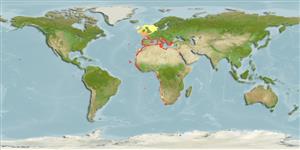Common names from other countries
Environment: milieu / climate zone / depth range / distribution range
पारिस्थितिकी
समुद्री; खारा ड़िमरसल; गैर प्रवासी; गहराई सीमा 20 - 500 m (Ref. 4510), usually ? - 150 m (Ref. 27000). Subtropical; 60°N - 35°S, 26°W - 36°E
Eastern Atlantic: British Isles (rare) to Senegal including Madeira, the Canary Islands, and Cape Verde. Also throughout the Mediterranean except Black Sea. South African species thought to be the same as population in the northeast Atlantic (Ref. 4313).
आकार / वज़न / Age
Maturity: Lm ? range ? - ? cm
Max length : 50.0 cm TL पुल्लिंग / अलिंग; (Ref. 4510); common length : 30.0 cm TL पुल्लिंग / अलिंग; (Ref. 2683); अधिकतम प्रकाशित वज़न: 3.0 kg (Ref. 40637)
पृष्ठीय रीढ़ (सम्पूर्ण) : 12; पृष्ठीय सौफट रेज़ (सम्पूर्ण) : 9; गुदा कांटा: 3; ऐनल सौफट रेज़: 5. Dark spot often on spinous dorsal (Ref. 4313).
Solitary and sedentary over rocky, sandy or muddy bottoms. Feeds on fishes, crustaceans and mollusks (Ref.4570).
Life cycle and mating behavior
Maturities | पुनरुत्पत्ति | Spawnings | Egg(s) | Fecundities | लार्वा
Hureau, J.-C. and N.I. Litvinenko, 1986. Scorpaenidae. p. 1211-1229. In P.J.P. Whitehead, M.-L. Bauchot, J.-C. Hureau, J. Nielsen and E. Tortonese (eds.) Fishes of the North-eastern Atlantic and the Mediterranean. UNESCO, Paris. Vol 3. (Ref. 4570)
IUCN Red List Status (Ref. 130435)
CITES (Ref. 128078)
Not Evaluated
Human uses
मात्स्यिकी: व्यापारिक; जलजीवालय: सार्वजनिक लजीवालय
साधन
Special reports
Download XML
इंटरनेट स्रोत
Estimates based on models
Preferred temperature (Ref.
115969): 11.1 - 18, mean 14.4 (based on 189 cells).
Phylogenetic diversity index (Ref.
82804): PD
50 = 0.5000 [Uniqueness, from 0.5 = low to 2.0 = high].
Bayesian length-weight: a=0.01318 (0.01129 - 0.01539), b=3.02 (2.98 - 3.06), in cm Total Length, based on LWR estimates for this species (Ref.
93245).
Trophic level (Ref.
69278): 4.3 ±0.5 se; based on diet studies.
लौटाव (Ref.
120179): निम्न, न्यूनतम जनसंख्या दुगनी होने का समय 4.5 - 14 वर्ष। (K=0.08).
Fishing Vulnerability (Ref.
59153): High to very high vulnerability (68 of 100).
Climate Vulnerability (Ref.
125649): Low vulnerability (18 of 100).
